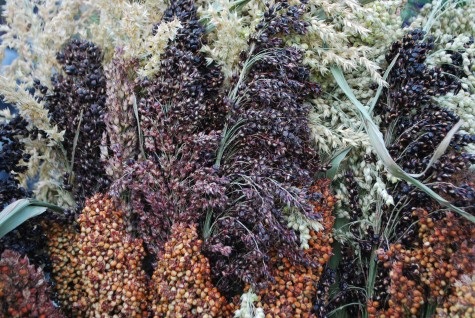
Broomcorn, or sorghum vulgare, is an annual that can grow to fifteen feet in a season. It is a crop grown primarily for the manufacture of brooms, and whisk brooms. It appears in the literature in the late 1500’s, in Italy; Benjamin Franklin is reputed to have introduced broomcorn to the US in 1700. Though I have been using broomcorn ornamentally in fall pots for years, the above mentioned facts I learned only yesterday. As I am focused on how plants look, I am impressed with that enterprising person that dried this plant, and made brooms. I will admit I did go and check out the broom in my office.

They make a swell centerpiece in a fall pot. For this six foot tall centerpiece, I loosely zip-tie two levels of material to a vinyl coated steel stake, and stuff my way down. The metal stake is a good idea-these stems are juicy, and very heavy. I like to use fresh cut sorghum and millet as they dry in whatever position you have them.
 The metal stake is inserted as close to the bottom of the pot as possible. A listing, out of vertical centerpiece-on my top ten list of things I really dislike. The long fibrous panicle of the broomcorn plant arches over gracefully in a pot. I repeat that graceful arching with some leggy Tuscan blue kale; this combination is a good foil for those utterly organized cabbages.
The metal stake is inserted as close to the bottom of the pot as possible. A listing, out of vertical centerpiece-on my top ten list of things I really dislike. The long fibrous panicle of the broomcorn plant arches over gracefully in a pot. I repeat that graceful arching with some leggy Tuscan blue kale; this combination is a good foil for those utterly organized cabbages.
 Sometimes I sort the broomcorn bunches for color. The dark stems are a beautiful compliment to this Francesco Del Re pot; plugs of angelina sedum infill the gaps. As I discussed yesterday, elevating the pots allows water to drain away freely. We will need this when dressing the pots for the winter.
Sometimes I sort the broomcorn bunches for color. The dark stems are a beautiful compliment to this Francesco Del Re pot; plugs of angelina sedum infill the gaps. As I discussed yesterday, elevating the pots allows water to drain away freely. We will need this when dressing the pots for the winter.
 The green-cream and peach sorghum contrasts well with its counterpart in a dark purple-brown. I do not know if any of these stems would pass muster for broom-making material, but they make for a great fall pot. That blue kale foliage is an unusual color in Michigan landscapes; it stands out.
The green-cream and peach sorghum contrasts well with its counterpart in a dark purple-brown. I do not know if any of these stems would pass muster for broom-making material, but they make for a great fall pot. That blue kale foliage is an unusual color in Michigan landscapes; it stands out.
 Ornamental cabbages only get better as the night temperatures drop; they color up. They are best planted as a tutu. Plants with a stiff aspect need some friendly and loose companionship. Thus this combination. The lime green angelina will take on an orange cast in cold weather, as in 37 degrees when I came to work this morning.
Ornamental cabbages only get better as the night temperatures drop; they color up. They are best planted as a tutu. Plants with a stiff aspect need some friendly and loose companionship. Thus this combination. The lime green angelina will take on an orange cast in cold weather, as in 37 degrees when I came to work this morning.
 This lace leaf kale is all about air, at the same time that it defines an overall shape. What more could any gardener ask of a plant? As kales and cabbages shed their lower leaves, I may bury the trunk as needed in the soil, and pitch the head forward some. The entire arrangement-saucy enough to attract attention.
This lace leaf kale is all about air, at the same time that it defines an overall shape. What more could any gardener ask of a plant? As kales and cabbages shed their lower leaves, I may bury the trunk as needed in the soil, and pitch the head forward some. The entire arrangement-saucy enough to attract attention.

I plant my clients pots four times a year; her pair of concrete squares, and three Francesco Del Re pots get dressed up for each season. Every season she is looking out her kitchen window expecting to see something beautiful. I suppose if I made a big issue of the history and ornamental use of broomcorn, she would listen. But her attention to that horticulture would not be the point. As I try to provide her with a view to something, I am interested in any plant, including a big rangy annual usually grown as a crop, that delivers.